

|
Spec-Zone .ru
спецификации, руководства, описания, API
|
The Java Control Panel is a multipurpose control panel. It allows you to view and set a wide range of parameters controlling how Java technology runs on your computer. It lets you view and delete temporary files used for Java Plug-in, which allows Java technology to be used by your Web browser to run applets; and Java Web Start, which allows you to run Java applications over the network. It allows you to control certificates, making it safe to run applets and applications over the network. It allows you to set runtime parameters for applets that run with Java Plug-in and applications that run with Java Web Start. It provides a mechanism for updating your version of the Java platform so that you always have the latest. And it allows you to set options for debugging, desktop integration, applet handling, etc. The Java Control Panel includes the following separately viewable panels:
Each is discussed below.
The General panel looks like this:
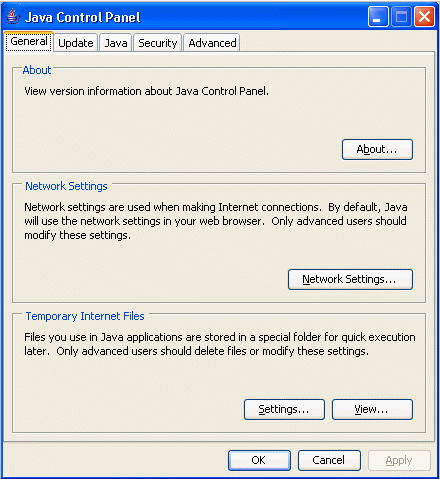
It includes three subpanels: About, Network Settings, and Temporary Internet Files.
The About... button displays version information for the latest JRE installed on the computer.
These settings are for network connections. Press the Network Settings... button to get the Network Settings dialog. There are four choices:
Check this to use the browser default proxy settings. This is the default setting (checked).
You have two choices here:
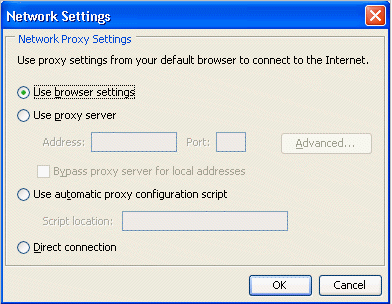
You can specify the location (URL) for the JavaScript file (.js
or .pac extension) that contains the FindProxyForURL
function. FindProxyForURL has the logic to determine
the proxy server to use for a connection request.
Select this for situations where you do not want to use a proxy.
You can do the following:
The Update panel looks like this:

NoteThis panel is only available on Windows for 1.4.2_01 and higher releases and only for users with Administrative privileges. |
The Update panel, in conjunction with the Java
Update Scheduler (jusched.exe), is used to provide the
latest Java updates to the end user.
There are two basic options on the Update tab:
Automatic update is performed on a scheduled basis and it is selected by checking the Check for Updates Automatically check box.
Manual update is performed by pressing the Update Now button.
If you select automatic update, you can then set the notification via the Notify Me: drop-down menu, and you can set the update schedule via the Advanced... button.
With notification, you can chose to be notified before an update is downloaded and before it is installed; or you can chose to be notified only before an update is installed (i.e., the download is automatic).
The Advanced... allows you to select the desired frequency for updates: daily, weekly (default), or monthly. For daily updates, you can select the time of the day for the update; for weekly updates, you can select the day of the week and the time of the day; for monthly updates, you can select the day of the month and the time of the day.
You can do manual updates at any time by pressing the Update Now button. This allows you to do immediate, unscheduled updates.
The Java Update Scheduler (jusched.exe) is used for
launching automatic updates when Update Automatically is
selected in the Update tab. jusched.exe runs as a
background process that launches the Update Manager at predefined
intervals set by the user through the Advanced ... button of
the Update tab. The Update Manager coordinates the update
process.
jusched.exe is launched when the user reboots the
computer after installing the SDK/JRE. It is normally transparent
to the user but can be viewed in the Processes tab of the Windows
Task Manager. Should a user for some reason not want the scheduler
to run, it can be killed via End Process button of the
Processes tab.
The Java panel looks like this:
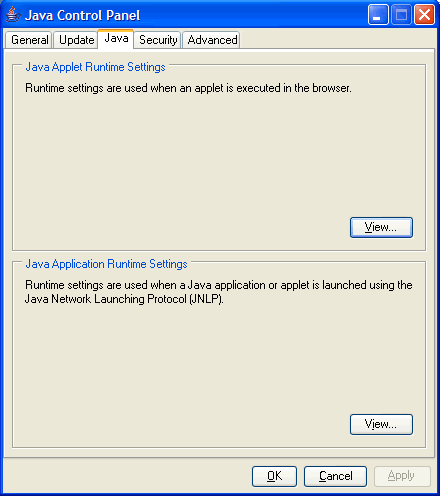
It has two subpanels: Java Applet Runtime Settings and Java Application Runtime Settings.
These settings will be used when an applet is launched in a browser. Press View... for the Java Runtime Settings for applets. On Windows you will see this:
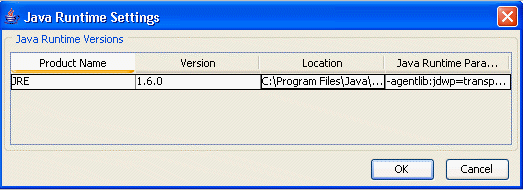
Note that on Unix there will also be Add and Remove buttons.
NotesThere will always be at least one entry. It will be the most recently installed JRE; i.e., the JRE associated with the Java Control Panel. Windows will show all JREs installed on a computer. The Java Control Panel finds the JREs by looking in the registry. On Unix the situation is different. There is no registry so there is no easy way to find the JREs that a user may have installed. Thus, for Unix there are Add and Remove buttons. For Unix, only version 5.0 or higher should be added. For Windows, where all JREs are found in the registry, only version 5.0 or higher will be displayed. Example:Assume you are running on Microsoft Windows with Microsoft Internet Explorer, have first installed version 1.4.2, then version 5.0, and you want to run 1.4.2.
|
On Unix you can add a JRE by pressing Add and specifying its location (see notes above).
For Window and Unix you can optionally set Java Runtime Settings for the JRE.
You can override the Java Plug-in default startup parameters by specifying custom options in the Java Runtime Parameters field. With the exception of setting
classpathandcp(see Settingclasspathandcpbelow), the syntax is the same as used with parameters to thejavacommand line invocation. See the java launcher for a full list of command line options:java launcher: Windows, Solaris and Linux.
Below are some examples of Java runtime parameters.
The following format should be used for setting
classpathandcpin Java Plug-in. It differs slightly from thejavacommand line format, which uses a space instead of the equal (=) sign.
-classpath=<path>
-cp=<path>Enabling and disabling assertion support
To enable assertion support, the following system property must be specified in the Java Runtime Parameters:
-[ enableassertions | ea ][:<package name>"..." | : <class name> ]To disable assertion in the Java Plug-in, specify the following in the Java Runtime Parameters:
-[ disableassertions | da ][:<package name>"..." | : <class name> ]See Assertion Facility for more details on enabling/disabling assertions.
Assertion is disabled in Java Plug-in code by default. Since the effect of assertion is determined during Java Plug-in startup, changing assertion settings in the Java Plug-in Control Panel will require a browser restart in order for the new settings to take effect.
Because Java code in Java Plug-in also has built-in assertion, it is possible to enable the assertion in Java Plug-in code through the following:
-[ enableassertions | ea ]:sun.pluginTracing and logging support
Tracing is a facility to redirect any output in the Java Console to a trace file (
.plugin<version>.trace).
-Djavaplugin.trace=true
-Djavaplugin.trace.option=basic|net|security|ext|liveconnectIf you do not want to use the default trace file name:
-Djavaplugin.trace.filename=<tracefilename>Similar to tracing, logging is a facility to redirect any output in the Java Console to a log file
(.plugin<version>.log) using the Java Logging API. Logging can be turned on by enabling the propertyjavaplugin.logging.
-Djavaplugin.logging=trueIf you do not want to use the default log file name, enter:
-Djavaplugin.log.filename=<logfilename>Furthermore, if you do not want to overwrite the trace and log files each session, you can set the property:
-Djavaplugin.outputfiles.overwrite=false.If the property is set to
false, then trace and log files will be uniquely named for each session. If the default trace and log file names are used, then the files would be named as follows
.plugin<username><date hash code>.trace
.plugin<username><date hash code>.logTracing and logging set through the Control Panel will take effect when the Plug-in is launched, but changes made through the Control Panel while a Plug-in is running will have no effect until a restart.
For more information about tracing and logging, see the chapter called Tracing and Logging.
Debugging applets in Java Plug-in
The following options are used when debugging applets in the Java Plug-in. For more information on this topic see the Debugging Support in the Java Plug-in Developer Guide.
-Djava.compiler=NONE
-Xnoagent
-Xdebug
-Xrunjdwp:transport=dt_shmem,address=<connect-address>,server=y,suspend=nThe
<connect-address>can be any string (example:2502) which is used by the Java Debugger (jdb) later to connect to the JVMDefault connection timeout
When a connection is made by an applet to a server and the server doesn't respond properly, the applet may appear to hang and may also cause the browser to hang, since by default there is no network connection timeout.
To avoid this problem, Java Plug-in 1.4 has added a default network timeout value (2 minutes) for all HTTP connections. You can override this setting in the Java Runtime Parameters:
-Dsun.net.client.defaultConnectTimeout=<value in milliseconds>Another networking property that you can set is
sun.net.client.defaultReadTimeout.
-Dsun.net.client.defaultReadTimeout=<value in milliseconds>
Note
Java Plug-in does not set
sun.net.client.defaultReadTimeoutby default. If you want to set it, do so through the Java Runtime Parameters as shown above.Networking properties description:
sun.net.client.defaultConnectTimeout
sun.net.client.defaultReadTimeoutThese properties specify, respectively, the default connect and read timeout values for the protocol handlers used by
java.net.URLConnection. The default value set by the protocol handlers is-1, which means there is no timeout set.
sun.net.client.defaultConnectTimeoutspecifies the timeout (in milliseconds) to establish the connection to the host. For example, for http connections it is the timeout when establishing the connection to the http server. For ftp connections it is the timeout when establishing the connection to ftp servers.
sun.net.client.defaultReadTimeoutspecifies the timeout (in milliseconds) when reading from an input stream when a connection is established to a resource.For the official description of these properties, see Networking Properties.
These settings will be used when a JNLP application is launched. Press View... for JNLP Java Runtime Settings. You will see this:
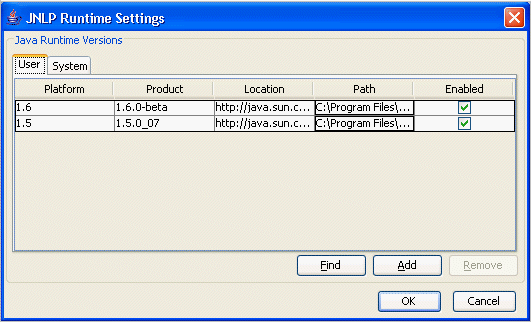
The Table contains the following information:
The panel includes the following buttons:
The Choose... button allows user to choose content of the Path (Command) field. This button becomes enabled when the user clicks on Path (Command) field of an existing JRE.
The Find... button pops up a tool that allows the user to find JREs installed on the system.
The Add button adds a new line to the table of JREs.
The Remove button removes a line from the table of JREs.
When the OK button is pressed, the changes will be saved in the config file and the dialog will be dismissed. When the Cancel button is pressed, the changes will be discarded and the dialog will be dismissed.
Notes
|
The Security panel looks like this:
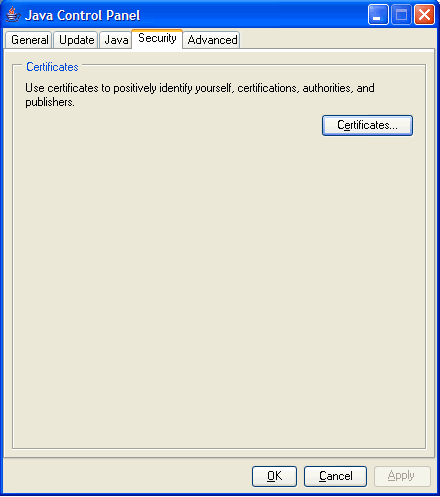
Press the Certificates... button to get the Certificates dialog, which looks like this:
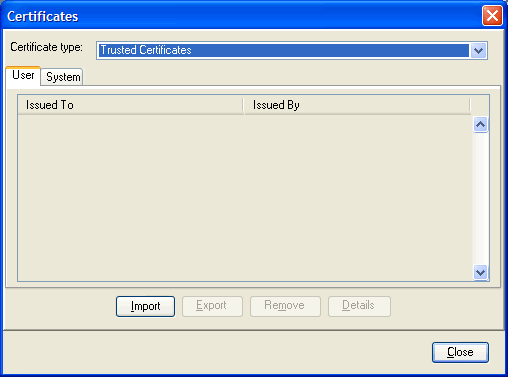
It handles both User- and System-Level (enterprise-wide) certificates of the following types:
These are certificates for signed applets and applications that are trusted.
These are certificates for secure sites.
These are certificates of Certificate Authorities (CAs) for Trusted Certificates; Certificate Authorities are the ones who issue the certificates to the signers of Trusted Certificates.
These are certificates of Certificate Authorities (CAs) for secure sites; Certificate Authorities are the ones who issue the certificates for secure sites.
These are certificates for a client to authenticate itself to a server.
Options
For Trusted, Secure site, and Client Authentication certificates, there are four options: Import, Export, Remove, and Details. The user can import, export, remove, and view the details of a certificate.
For Signer CA and Secure site CA, there is only one option: Details. The user can only view the details of a certificate.
Default Keystore Location
The default locations of the of the
keystorefiles for Unix and Windows are as follows:
Unix ${user.home}/.java/deployment/security.Windows
${deployment.user.home}\securityFor instance, on Windows 2000/XP, the default location of the
keystorefiles for userjsmithwould be as follows:
C:\Documents and Settings\jsmith\Application Data\Sun\Java\Deployment\securityNon-Default Keystore Location
For non-default locations of the certificate
keystorefiles, specify them in the User-Leveldeployment.properties filewith the following property names:
Trusted Certificates deployment.user.security.trusted.certsSecure site deployment.user.security.trusted.jssecertsSigner CA deployment.user.security.trusted.cacertsSecure site CA deployment.user.security.trusted.jssecacertsClient Authentication deployment.user.security.trusted.clientcerts
Options
For System-Level certificates, the only options a user has are Export and Details.
Default Keystore Location
Trusted, Secure Site, and Client Authentication certificate
keystorefiles do not exist by default. Thus there are no default locations for them.The default location for the Signer CA keystore is:
Unix $JAVA_HOME/lib/security/cacertsWindows
$JAVA_HOME\lib\security\cacerts
The default location for the Secure Site CA keystore is:
Unix $JAVA_HOME/lib/security/jssecacertsWindows
$JAVA_HOME\lib\security\jssecacerts
Non-Default Keystore Location
The location of the
keystorefiles for the various types of certificates can also be set in a System-Leveldeployment.propertiesfile, if it exists. (The System-Leveldeployment.propertiesfile does not exist by default. It is specified in adeployment.configfile. See System-Leveldeployment.properties file.) The following properties may be specified:
Trusted Certificates deployment.system.security.trusted.certsSecure site deployment.system.security.trusted.jssecertsSigner CA deployment.system.security.trusted.cacertsSecure site CA deployment.system.security.trusted.jssecacertsClient Authentication deployment.system.security.trusted.clientcerts
The Advanced panel looks like this:
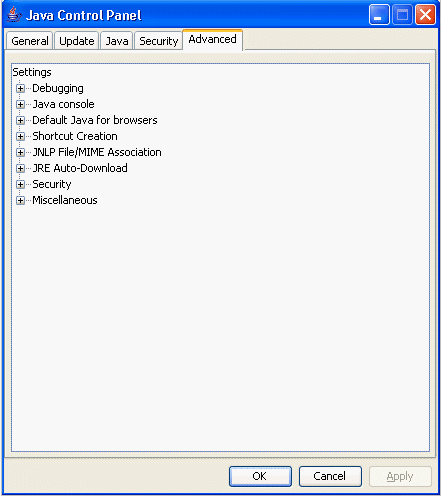
It includes options for Debugging, Java console, Default Java for Browsers, Desktop integration, JNLP File/MIME Association, and Security.
You can enable tracing and logging. For more information on tracing and logging and how to set runtime parameters for tracing and logging, see Tracing and Logging.
There are three options:
See Java Console for information about it.
<APPLET> tag support (Windows
only)Here you can specify whether a particular browser
should use the Sun VM for the standard <APPLET>
tag.
NoteIf Mozilla and Netscape 7 are both installed and
|
This provides options for Java Web Start for creating shortcuts on the desktop. The options are:
This allows you to associate files with the JNLP MIME type. The options are (radio button, select only one):
The options are check boxes. You can select any number of available options. All options are checked by default except for those specified. The following are the various Java security options:
Here you have the option to place the Java icon in the system tray (default).
Allows you to specify the location of the default browser to be launched.
| Java Technology |
Copyright © 1993, 2010, Oracle and/or its affiliates. All rights reserved. |